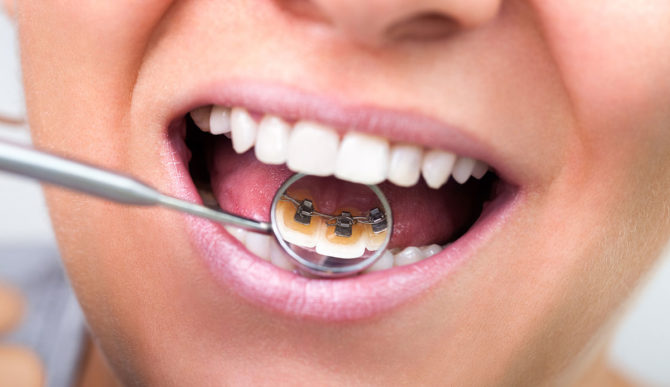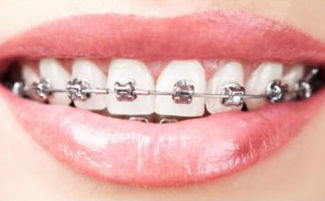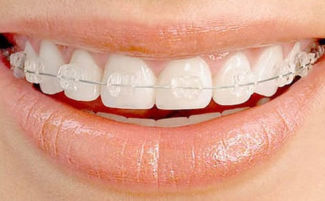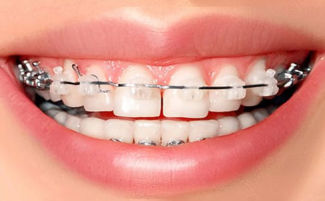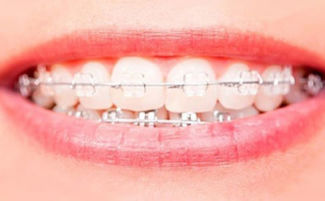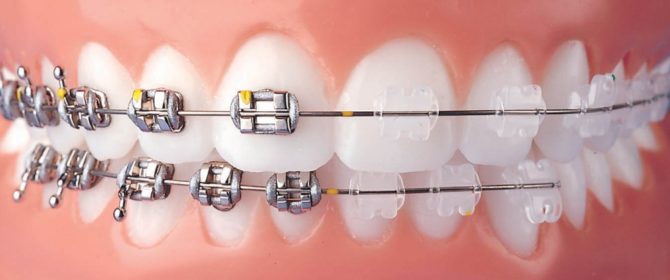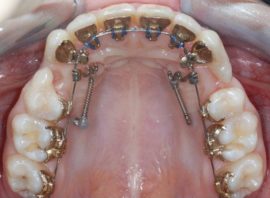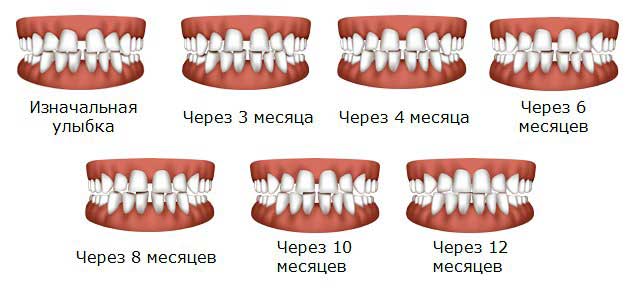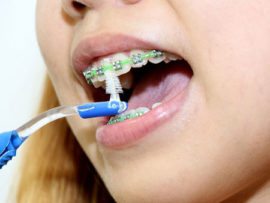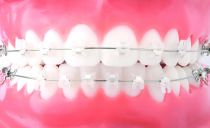How to put braces on teeth: types, terms of wearing and installation
A smile is an adornment of a person’s face. Improper bite and crooked teeth can spoil even the perfect appearance, so in this case the question arises about installing braces. The way braces are set and how long the process takes depends on type selected bracket system.
Content
Types of bracket systems
Bracket system (translated from English. bracket - bracket) - fixed design used to correct malocclusion and imperfections in the dentition. The mechanism includes braces that are attached to the teeth, a wire arch, locks, ligatures and elastic rods that will be worn on hooks. The complexity of the installation and how long the brackets are placed depends on their type.
The main types of bracket systems:
- Vestibular the systems are installed on the outside of the teeth, the arc joins the system with the help of locks. Installation of vestibular devices takes less than an hour.
- Lingual systems are attached to the inner surface of the dentition and are almost invisible to others. Fixing lingual braces is a more time-consuming process that takes longer. The duration of the procedure is sometimes more than three hours.
In small cities, it is difficult to find a specialist who can offer quality treatment with a lingual apparatus. The ability to install an invisible bracket system is available in clinics in Moscow, St. Petersburg and other large cities, where doctors can develop an adequate treatment plan in the laboratory.
External bracket systems are additionally classified depending on the material from which the brackets are made:
- Metal. A budget option that has been successfully applied in orthodontics for several decades. Metal devices are strong and reliable, but with a conversation or a smile, the design can be very striking.
- Plastic They are made of plastic, which is painted in the color closest to the color of the patient’s teeth. Plastic bracket systems are unreliable and more prone to staining and breakage.
- Ceramic. These braces are transparent and almost invisible on the teeth. The disadvantage is that the ceramics stain from tea, coffee and cigarettes, so some habits will have to be abandoned for the treatment period. Another disadvantage is that ceramic devices are quite fragile and often break.
- Sapphire. Just like ceramic, they are transparent, but do not tend to stain over time. Artificial sapphire staples are the most expensive of aesthetic vestibular systems.
Photos of different types of braces:
Indications for installing braces
Indications for the installation of the bracket system are malocclusion: prognathy, progenia, open or deep bite, diastema, as well as curvature of the dentition, incorrectly grown fangs or incisors. Bite defects are not only an aesthetic problem, they often entail speech disorders, diseases of the teeth and temporomandibular joint and can lead to complete loss of teeth.
You can install braces from 11-12 years old, since at this age the child completes the formation of the dentition. There is no upper limit for installing a bracket system.
An obstacle to the installation of the structure may be:
- Caries;
- Enamel defects;
- A large number of fillings, crowns, implants;
- Periodontitis;
- Allergy to the materials used by the orthodontist;
- Mental disorders;
- Blood diseases
- Sexually transmitted diseases;
- HIV AIDS;
- Oncology.
Bracket System Installation Steps
Before braces are placed, preparation of the oral cavity is mandatory. It is impossible to attach the design to diseased and contaminated teeth, therefore, before orthodontic treatment, the patient removes carious lesions and conduct professional hygienic cleaning. How long this stage will last depends on the condition of the patient's oral cavity and teeth.
After preparation, the doctor can begin the process of installing the bracket system. Fixation usually begins with the upper jaw. The way braces are placed depends on the type of construction.
Installation of vestibular braces
The orthodontist begins the installation of vestibular braces by inserting a rotary expander into the patient’s mouth - a device that allows access to all teeth. The external surface of the dentition is polished, treated with restorative composition and dried. After the doctor puts on the enamel a special glue - bond - on which braces are attached. The material hardens like cement and holds the bracket firmly to the surface. After hardening on braces, an arc is attached that will move the teeth in the right direction.
The video shows how to put metal braces on your teeth:
Installation of lingual braces
Before installing lingual braces, the doctor makes an exact copy of the dentition. The design of the bracket system is made individually for each patient and pre-fixed on the cast of the jaw. After lingual braces, as well as external, are attached to the surface of the teeth using a bond.
The Incognito braces installation video shows how to fix the lingual system on the teeth:
Pain during installation and treatment
While braces are attached to the teeth, the patient does not experience any unpleasant sensations. The procedure is absolutely painless and even the child easily tolerates the installation.
Immediately after installation, discomfort may be observed due to the sensation of a foreign body in the mouth; problems with diction may occur, especially with regard to lingual braces. This is normal, the body needs time to get used to the braces.
A couple of hours after installation, pain may occur due to the fact that the process of movement has begun. This process is individual and depends on the severity of the malocclusion and pain sensitivity of the patient. In the case of severe, intolerable pain, you can take an anesthetic.
Vestibular braces often rub and injure the mucous membrane of the lips and cheeks. In this case, the protruding parts of the braces are covered with orthodontic wax, which protects the soft tissues from traumatic effects.
After braces are installed, every 2-3 months, the patient is obliged to visit a doctor to monitor the treatment process and correction. Gradually, the orthodontic arches will be replaced by more rigid ones, which can also cause discomfort and pain. This indicates a positive trend in the treatment and that the dentition is gradually shifting in the right direction.
How long do you need to wear braces
Braces are a non-removable design that involves wearing over time. The term for how many braces are placed depends on several factors:
- Type of installed bracket system;
- The degree of difficulty in correcting the anomaly;
- The age of the patient.
The duration of wearing external braces is on average from 1 to 2 years, but in some cases it can decrease, or vice versa, increase.
Lingual braces correct an occlusion on average, twice as fast as external ones. This is due to the fact that the inner arc has a stronger effect on the teeth and the first results will be noticeable after a month of wearing.
In childhood and adolescence, the process of movement of the dentition is faster than in adults. The most effective installation of braces is at the age of 11-13 years, since after 14 years the dynamics of the jaw apparatus and the position of the teeth slows down.
How much braces are placed on teeth in adulthood depends on the particular case. Correction of minor deviations may take less than a year, serious defects will require a longer time - on average, 1.5–3 years. In some cases, the duration of wearing the bracket system is more than three years.
Dental care while wearing braces
After braces have been placed on the teeth, the orthodontist consults the patient about all the nuances of dental care during the treatment period. In the first place is oral hygiene, as braces complicate the process of brushing your teeth, and in hard-to-reach places plaque accumulates very quickly.
- Teeth must be cleaned after each meal. For more convenient cleaning, you can use special brushes with shortened villi in the middle and single-beam brushes. They allow you to effectively clean the bracket system itself and remove bacteria from inaccessible places, such as wisdom teeth and the space in the place of attachment of the bracket. If it is not possible to clean after eating, rinse your mouth with water or a special rinse aid.
- Brushes for teeth - an indispensable thing after installing braces. They perfectly cope with the task of cleaning the interdental space, in which plaque and bacteria can accumulate. Brushes are sold in pharmacies in a wide range, among which everyone will be able to pick up a tool for their size. An orthodontic thread (floss) is also necessary in the care of the bracket system. Some flosses are saturated with fluoride for better care.
- Best if the toothpaste used during treatment will contain fluoride. This element prevents the growth of bacteria and the development of caries, which is very important during orthodontic treatment.
- During the treatment period, the patient will have to abandon many products. Crackers, nuts and other hard foods that can damage the bracket system are not allowed during treatment. When wearing plastic and ceramic devices, it is not recommended to abuse coloring products such as tea, coffee, juices.
Do braces apply to fillings, crowns and implants?
Many people in adulthood are interested in how to put braces on teeth with fillings and crowns and whether braces can be placed on an implant. These issues are usually dealt with individually. The presence of a quality seal is not a contraindication to treatment with a bracket system, however, an old poor seal must be redone before fixation. If the seal is located directly in the place where you want to fix the bracket, this can become an obstacle to the installation of the system.
Staples can also be placed on crowns, since the tooth underneath remains alive and able to move. However, here the patient needs to be doubly accurate - nevertheless, on the native enamel the structure is held more securely than on the crown and mechanical stress can cause the bracket to break or fall off.
When installing a bracket system on an implant, there are several nuances. The implant cannot move along with the rest of the dentition, but can fall out under the pressure of the device, so if possible, then the implant is better to be implanted after the bite is aligned. If the bite defect is insignificant and there is the possibility of installing the system without fixing the bracket on the implant, treatment can be quite successful.
The bracket system can be delivered even in the absence of one or more teeth. The doctor may suggest that the patient install implants, or install braces on existing teeth without affecting the openings. However, to move the dentition and close the hole in place of the missing tooth with the help of braces will not work - this is a complex process, the result of which is difficult to predict.
Only an orthodontist will accurately determine whether it is possible to correct the bite with braces in a particular case. Much depends on the condition of the teeth, on the quality of the restoration and on the goal that the patient pursues, choosing in favor of treatment with a bracket system. Reliable information can only be obtained by consulting a specialist.

